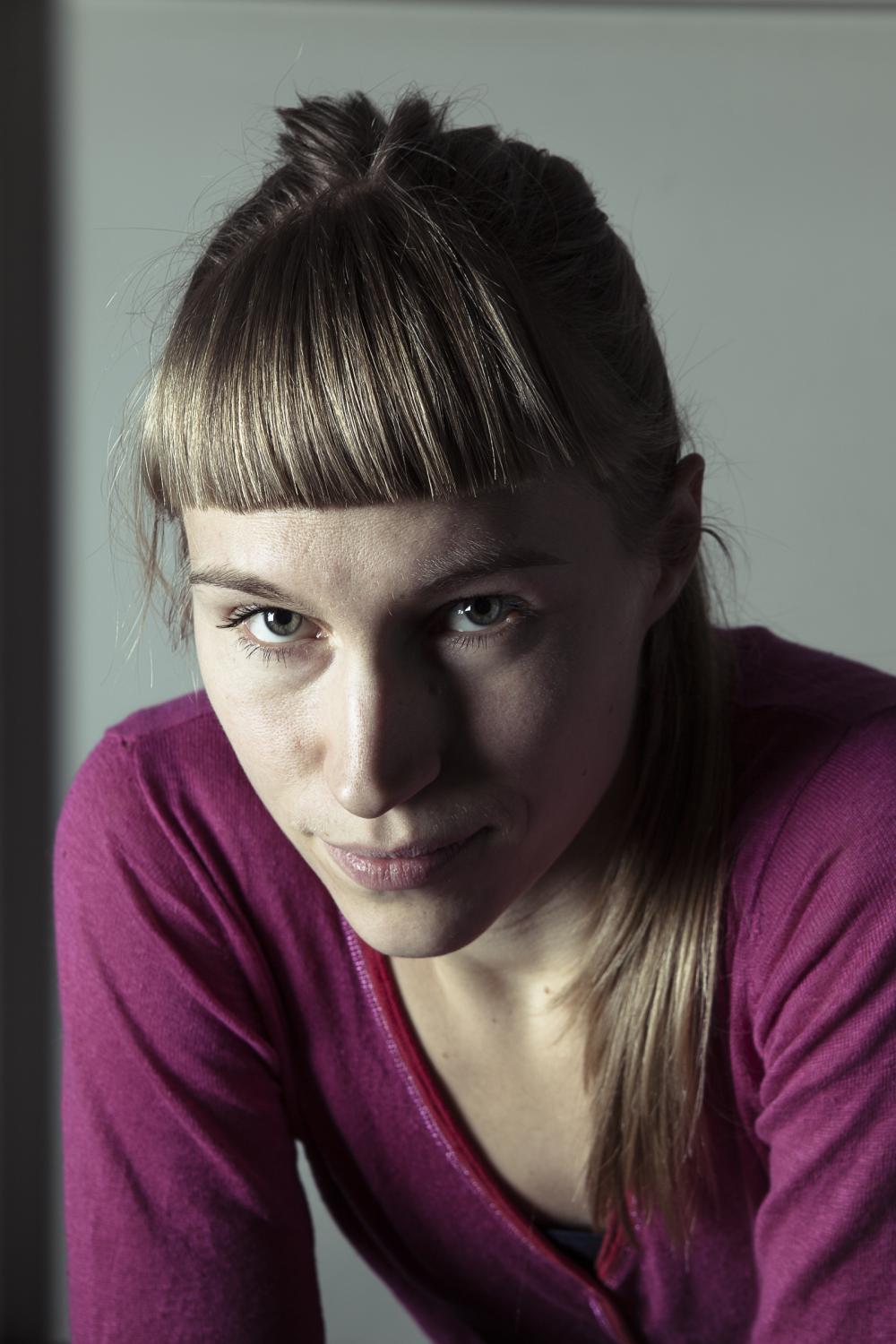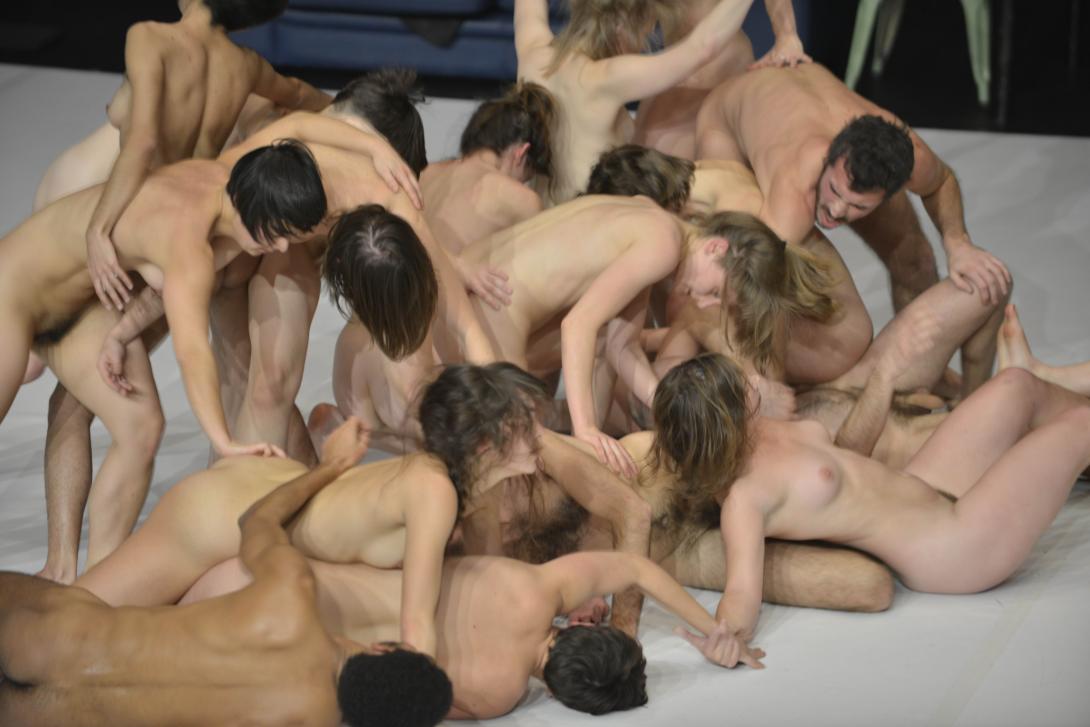The Red Pieces
an interview with Mette Ingvartsen
In her latest performance cycle The Red Pieces, Danish choreographer Mette Ingvartsen investigates the role of nudity and sexuality in our society. In October she will present 69 Positions and 7 Pleasures at Kaaitheater, followed by a conference with performative proposals, lectures and discussions. ‘I use a soft tone, even though the things I ask sometimes come close to the edge of what is comfortable.’
Can you tell us something about the cycle The Red Pieces and your preference for creating work in series?
When I started creating choreographies, I wanted the pieces to be singular and independent from one another. That has changed over the last five years because certain topics kept on resurfacing. The Artificial Nature Series, for instance, retrospectively turned into a cycle when I noticed that the five separate pieces dealt with the same topics, and fit together perfectly. The Red Pieces is the first time that I have conceived a series of works that were connected beforehand. For me, working in cycles generates more time to really think through a topic and experiment with the various formats of performance and different relations to the public. The space of 69 Positions is very small and intimate: people can move around me in the room. I call it a discursive practice performance: it unfolds somewhere between language, actions, gestures and dances. With 7 Pleasures I decided to return to a frontal use of the stage, while still thinking of ways to extend the stage into the audience area. It’s a reflection on how sexual and erotic bodies are very often represented as flat two-dimensional images, and on the potentiality of theatre to treat these bodies differently.
What about the figures 69 and 7, in 69 Positions and 7 Pleasures?
For me, 69 Positions refers to two things: on the one hand it signifies the egalitarian sexual position. My work often deals with thinking about egalitarian structures, and 69 as a figure has an inversed symmetry. In this sense, equality includes the possibility of being different from one another, yet equal.
On the other hand 69 Positions goes through a history of performances, starting in the Sixties. I take up various positions from different works: sometimes I’m speaking as a performer in one of the shows, sometimes as a guide who is giving a tour, sometimes I’m really embodying an extract of a dance. My body transforms while going through all these different positions. Initially I wanted to use exactly 69 references to create an overview, but that turned out to be simply too much!
People often associate the 7 in 7 Pleasures with the seven deadly sins – and there is definitely a link – but the piece isn’t meant as a concrete response to the sins. Nevertheless, it’s a reflection on how a certain cultural history is still living in our bodies today, and how it influences our sexual practices. For instance, I find it interesting to see how sexuality is still very much connected to religion, and how mechanisms of guilt and shame still operate within our bodies.
With 7 Pleasures I was concerned with understanding where we are today in regards to sexuality. How our sexuality is being manipulated and controlled on a molecular level. The testosterone practice I speak about in 69 Positions is a very clear example: you take testosterone, which changes your hormonal balance leading to modifications in the ways you can desire. The same happens when you take Viagra, birth control pills, or other pharmaceutical products designed to affect your sexual drive or reproductive capacities. I think these modifications of desire demonstrate that our bodies are very fragile, even now. Our affects and sensations make us susceptible to all kinds of forms of control and speculation. Moreover, these levels of the body are not necessarily very conscious.
In 69 Positions you return to the sexuality, nudity and participation of the Sixties. Why now?
In the Sixties there was this utopia of coming together through sexual liberation. The ideal failed and we are still dealing with its consequences today. In Scandinavia, and especially Sweden, equality has achieved a stronger position in society. But generally speaking, the struggles of the Sixties and Seventies – equal pay for equal work, new distributions of labour or responsibilities towards children – have not been completely successful. This is a fitting reason to look back and try to understand the movements of that time period.
69 Positions initially came about as a reaction to my own work. In The Artificial Nature Project I had been working with the material agency of things and with making dehumanized choreographies. I felt a need to return to the human body: sexuality appeared as an interesting territory to further think about the collective and participation. Today I think there is a tremendous need to assemble together inside and outside the theatre. This is especially important in times of social and political crises, of insecurity and instability. I’m also thinking about the questions of public/private and how social media in a way disrupt the private space by revealing intimate information.
How do you translate this disruption between public and private into your performances?
In 69 Positions I employ a technique I call soft choreography. Historically, much work on sexuality has dealt with aggression and confrontation, which can stir rejection from the audience. I tried to find another strategy to include the audience, thinking together about the topic, instead of rejecting it. That’s why I use a soft tone, even though the things I ask sometimes come close to the edge of what is comfortable. Some of the Sixties’ performances I’m referring to proposed to initiate an orgy – and at that time that’s what sometimes happened. The belief in the collective differed from today. The participatory aspect of 69 Positions rather deals with the moment when, as a spectator, you negotiate whether or not you will take the step to participate. In this moment of negotiation something actually happens to your limits: is it okay to do this or not? Do I want to be part of this collective, and in which way?
You created 7 Pleasures for the big stage in a frontal setting. But there, too, you involve the audience.
In 7 Pleasures we work with a choreographic principal that I call spilling. The basic idea is to let the performance spill onto the area where the audience is sitting. In the opening scene, the performers undress in the audience. There is a suggestion that the performers’ bodies are very similar to the bodies of the spectators. Our practices are neither crazy, nor so virtuosic that no one else could imagine doing them. At the same time, we try to include the entire environment into our choreography: the audience is part of it, so are the staircase and the objects around us.
We see a lot of nakedness in 7 Pleasures, but more in a sensual than a sexual way.
That says a lot about the way we understand the word ‘sexual’ today! If there is no penetration, there is no sex, right? In this piece there is no penetration, but I still think what we do can be considered a form of sexual practice. The performers pose questions of what pleasure is, of how we feel it, and of how it can change our bodies to sense pleasure in different and unfamiliar ways. The piece is created through different modes of intimate togetherness.
The first section deals with getting away from the parts of our body that are certainly erotising. It’s true that certain body parts have more nerve endings than others, but we underestimate the incredible potential of sensations that other parts of the body also possess. In the second section we work with vibrations. Our individual bodies dissolve into one vibrational mass that at a certain point also includes all the objects on stage. We extend the notion of desire between humans to include the relation with the environment and its objects. During the last section, half of the performers are dressed in black clothes, while the other half remains naked. There we focus on the ways power and violence operate within sexual images. We do it in such a way that makes it difficult to determine who is manipulating and who is being manipulated, who is giving and who is receiving the pleasure.
As a preparation of the third and final part of The Red Pieces you organise The Permeable Stage: a ten-hour performative conference. What can we expect?
The idea behind the conference is to create a time and space for thinking collectively about sexuality as an expanded field of research. This means looking for the intersection between the sexual, the social and the political. Artists, theorists, musicians as well as a chef cook, create a space for informal conversations and presentations of various kinds. Come join us!
Mette Ingvartsen (artist-in-residence 2013-2016) in conversation with Katleen Van Langendonck (artistic directorKaaitheater) & Eva Decaesstecker (communicationKaaitheater)



